Authors
Roland Hunziker, Director, Built Environment
New York Climate Week provided a platform for sustainability leaders to tackle one of the most pressing challenges of our time: transforming the built environment to combat the climate crisis. This article explores insights gained from a CEO dialogue and a full value chain workshop WBCSD hosted during Climate Week, shedding light on the business leadership and the collaborative actions needed in the next 1-3 years to halve built environment emissions by 2030 and achieve full decarbonization by 2050.
The built environment accounts for 40% of global energy-related CO2 emissions, half of total global resource use, 13% of global GDP and two thirds of global wealth. As of 2021, total global emissions from constructing and operating buildings and infrastructure around the world were still on the rise, reaching an all-time high of close to 14Gt CO2, according to the annual Global Status Report for Buildings and Construction. We need a massive transformation to halve emissions by 2030 (in less than 7 years) and reach net zero emissions along the full life cycle by no later than 2050.
It is only with a systemic approach, deep collaboration of all actors toward a common vision, and a focus on the full life-cycle emissions that we can achieve this transformation. This is precisely what the Built Environment Market Transformation initiative is about. In the run-up to COP28 and the first Global Forum on Buildings and Climate in March 2024, WBCSD, in partnership with the Global Alliance for Buildings and Construction (GlobalABC), is convening actors from the full value chain, as well as from finance and policy, in a series of in-person and online workshops to identify the critical market barriers and a set of collective global actions to overcome those barriers.
The expected outcome of this initiative is a collective action agenda that is endorsed by a critical mass of key actors, and a prioritized set of advocacy messages for national governments as part of the Buildings Breakthrough Initiative. It will hone down on a series of targeted interventions along the value chain that will be implemented in a 1-3 year horizon to shift the system into delivering decarbonization at scale.
Insights from the New York Climate Week CEO Dialogue
On 19 September 2023, CEOs and C-suite representatives of some of the world’s leading companies came together during New York Climate Week to discuss how to accelerate the transformation of the built environment to become fully decarbonized and resilient, globally. The CEO Dialogue, hosted by Skanska USA at the iconic Empire State Building, brought together the leaders of global companies Arcadis, Johnson Controls, Saint-Gobain, Skanska, Trane Technologies and AXA IM Alts, as well as representatives from the French and US governments, to share their reflections on the needed transformation. In tune with Climate Week’s official motto, “We can. We will.”, these CEOs shared a positive and engaging message that we have the solutions available to deeply reduce energy consumption and CO2 emissions and to create healthier, more productive and resilient buildings for all people.
Once you get people aware of what you can do, you create an incredible momentum: understanding the whole value chain, what technology is available, and how that gets deployed in the best way.
George Oliver, Chairman and CEO of Johnson Controls
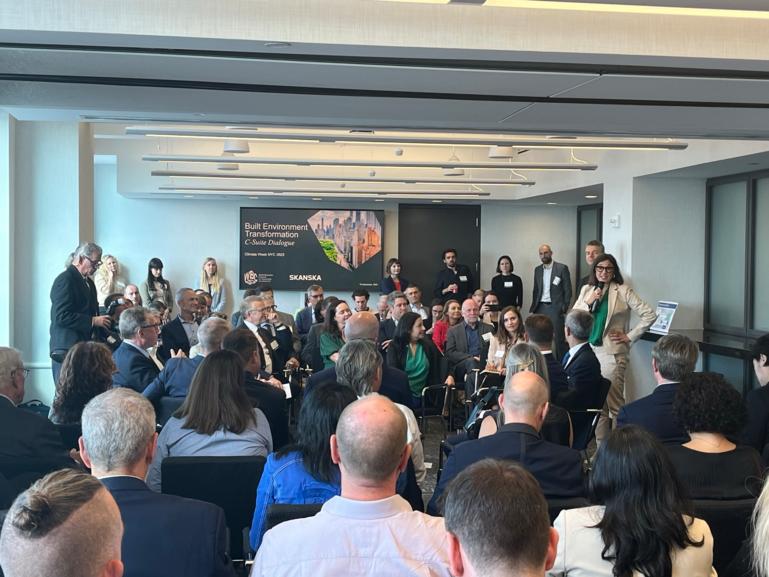
The CEOs spoke about how they act to decarbonize their own operations and supply chains, and they called for deeper collaboration along the value chain to reinforce each other’s actions and stressed the co-benefits of decarbonizing buildings in terms of health, well-being and reducing costs for occupants, and the creation of (local) jobs.
We need to collaborate much more radically and share data and challenges openly. If we can create a common sense of purpose in this industry, then we will also attract the best people.
Alan Brookes, CEO, Arcadis
While technology and collaborative solutions are key, we also need to ensure we have the workforce required to implement them.
We have the technologies and the collaborations, but we also need people to seek new training programs and for employers to offer on-the-job training opportunities to accelerate the deployment of the new knowledge and technologies.
Jetta Wong, Senior Advisor on Climate, US General Services Administration
What is possibly most critical is to show investors that there is a positive business case to be made for decarbonizing built assets and making them more resilient.
We need to change the assessment of risks and costs in financial decision-making, as this will shift the market.
Diane Holdorf, Executive Vice President, WBCSD
This can only be achieved with a shift in the perception of market players that assets that are not decarbonized will lose value, reflected in a change in their valuation. Such a transformation can be achieved through a collective shift among all market participants, through changes in regulation, or a combination thereof.
We need to do a better job at pricing risk. What looks good on paper does not always work in practice. The time horizon of deployed capital also plays a key role.
Justin Travlos, Global Head of Responsible Investments, AXA IM Alts
In mature markets, more than 85% of the buildings standing today will still be used in 2050. That means that renovation and retrofitting will play a crucial role in moving the built environment toward net zero and resilience. Estimates show that retrofitting an already existing building can result in 50-75% lower carbon emissions compared to building the same structure from scratch.
Retrofit of buildings is perceived as unattractive. We need to change that. It is critical to achieve the energy transition and to provide more comfort, health and well-being to people.
Benoit Bazin, CEO, Saint-Gobain
We need to change the expectations we have on buildings – they can deliver many positive benefits. For example, they can produce more energy than they need.
Lena Hök, EVP Sustainability and Innovation, Skanska
The CEO Dialogue concluded with a clear call to action, to which the Market Transformation initiative will respond:
- We need to raise the profile of the built environment as a fundamental enabler of the energy transition and guarantor of a healthy and prosperous life.
- We need short-term actions (in 2024) and results, and more examples of collaborative initiatives between companies to reach critical mass, not only individual company actions;
- We need to get better at collecting lessons learned and sharing them widely;
- It is fundamental to agree on some basic common principles and standards to overcome the fragmentation;
- It is critical to make the business case by reducing the risks and increasing the benefits of decarbonization;
- Finally, we need to send a clear signal to governments around the world urging them to set a high ambition through their regulations, actions and building codes, because the building sector stakeholders are ready for ambitious and predictable regulations.
It’s actually a whole system of solutions that’s needed. It’s not just about the materials, the technical, electronic, or digital solutions, or, for that part, the energy, the financing, or the regulations. It is all mixed together, and what’s needed is concrete action.
Lena Hök, EVP Sustainability and Innovation, Skanska
If we scale the technology that exists today, we can dramatically reduce emissions from the built environment. We all know what we have to do. We need ambitious goals, but it is also critical to have a glide path, so you know what you have to achieve every year.
Dave Regnery, Chair and CEO, Trane Technologies
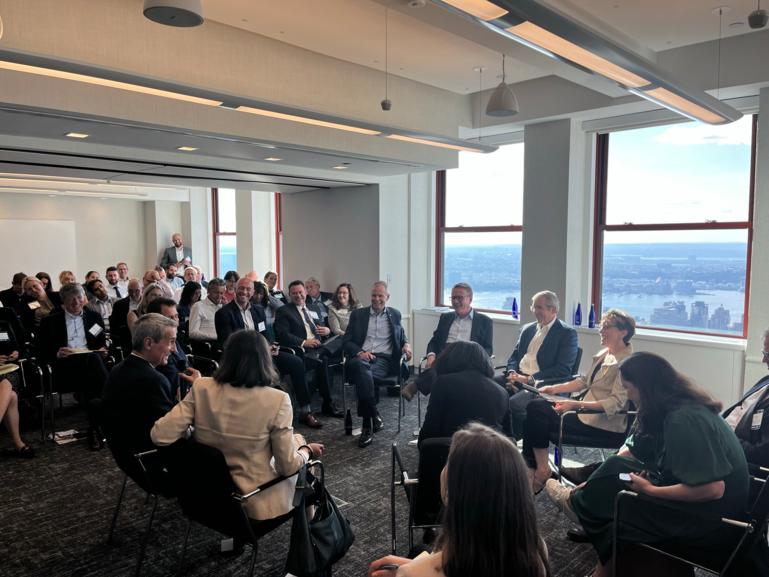
Insights from the New York Climate Week market transformation workshop
To initiate such a collective shift in market dynamics, on 20 September 2023, the day after the CEO Dialogue, over 80 professionals from companies and organizations representing the full value chain came back together for the second Built Environment Market Transformation workshop. They discussed a series of critical interventions that would help to collectively address the key market barriers faced today. These interventions follow the logic laid out in the original work on the Market Transformation Levers by WBCSD and the GlobalABC, which states that:
All actors from business, finance, policy and science need to have a shared understanding of the importance of the built environment for climate mitigation and a common vision for its urgent decarbonization as a system, and the importance of radical and deep collaboration across all stakeholders, focusing on the following three levers:
1. Adopt life-cycle thinking and Whole-Life Carbon Assessment across the full value chain, and align key indicators, metrics and targets accordingly.
2. Integrate the carbon cost and reflect it in the price of products and services throughout the value chain, including in procurement and taxonomy.
3. Transform the supply and demand dynamics to incentivize low-carbon solutions based on the Whole-Life Carbon approach.
So what did the New York workshop produce? In the words of one workshop participant: “So far at climate week, this session led by WBCSD wins my personal prize for the most productive and action-oriented of the week. The conversation was towards industry and stakeholder alignment around a set of common goals for the building sector, as well as a set of practical interventions that will help us achieve those goals. It got technical and nerdy, and we talked finance, carbon accounting, narrative building and much more.”
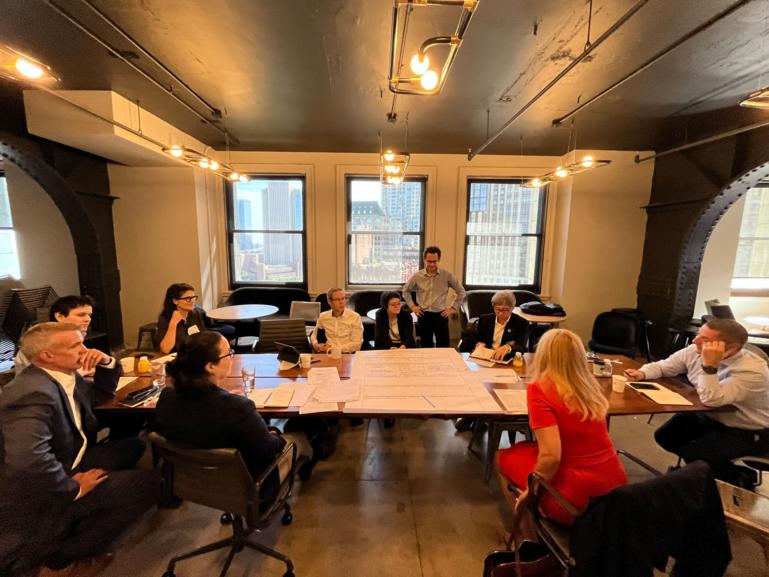
Concretely, the participants pondered over a total of 11 proposed interventions that, individually and collectively, help overcome specific market barriers in the next 1-3 years, based on the analysis of those barriers in the first Market Transformation workshop a few months back. The interventions can be summarized as follows (a more detailed analysis and summary is in development):
Vision and deep collaboration
1. Unequivocal near-term common goals: Create a global program that provides the overall vision and coordination among actors on tackling the critical barriers and connecting these to concrete actions on the ground,
2. Organizational adaptation: Help companies overcome internal barriers to transformation in terms of governance, remuneration, data management, etc.
Lever 1: Adopt Whole Life Carbon Assessment
3. Whole life carbon accounting: Adopt a globally consistent and transparent approach to Whole Life Carbon assessment to support target setting and accountability;
4. Overcoming data stagnation: Develop a global data ecosystem architecture to clarify what data is needed by whom, and how it can flow along the value chain;
5. Target simplification: Foster the development and adoption of regionally relevant science-based targets (glide paths) by relevant standards, codes and certification setters.
Lever 2: Integrate carbon cost in decision-making
6. Carbon pricing: Create the business case for a real estate-specific carbon pricing price, develop and test the methodology in pilot regions;
7. Transition risk integration: Fast-track the adoption of emerging transition risk assessment guidelines for investors, lenders and insurers to consistently reflect and disclose transition risk in property valuation.
Lever 3: Transform demand and supply dynamics
8. Sharing innovation risk: Develop new performance-based mechanisms for risk sharing in public and private contracts to incentivize deep decarbonization of built projects;
9. Buying commitments: Scale up demand signals through the creation of advanced market commitments for critical decarbonization solutions (based on life cycle performance);
10. Financing stranded assets: Pilot and showcase new dedicated brown to green financial instruments, leveraging energy- and co-benefits related revenue streams and business models;
11. Mobilizing tenant demand: Foster new strategic alliances and business models to align incentives and actions between landlords and tenants.
Each of these interventions identifies and tackles the barriers that were specifically selected by companies as holding back progress on the 3 market transformation levers. Collectively, they represent the building blocks of a successful transformation of the whole built environment system to deliver decarbonization at scale.
It is important to note that some interventions may already be partly or fully tackled by existing initiatives. What we are trying to achieve is to bring such initiatives together in a common global narrative so that they support and reinforce each other, to avoid duplication, and to identify gaps for new interventions to be developed and connected to each other.
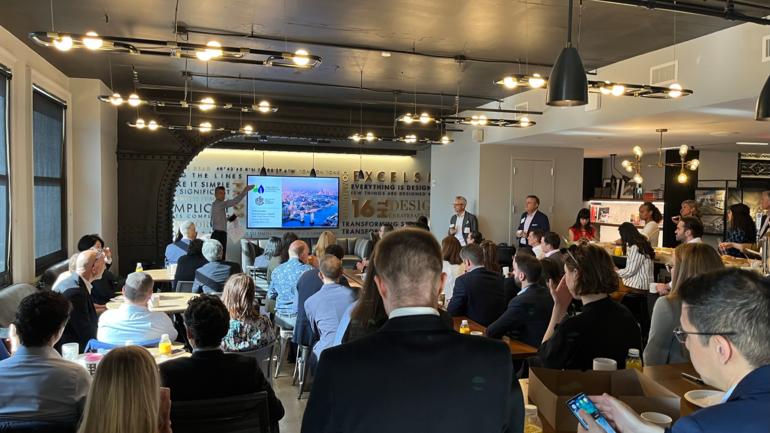
The path ahead
Based on the rich discussions and input from the CEO dialogue and the Market Transformation workshop, superbly hosted by Arcadis and facilitated by 103 Ventures, the next steps will be to sharpen the interventions into a set of collective global actions that can be delivered in the next 1-3 years in order to shift the built environment value chain to prioritize and incentivize carbon reductions at scale. This collective action agenda will be further shaped and refined at COP28 and then presented for launch and implementation at the Global Forum on Buildings and Climate in Paris in March 2024, as a potential supporting initiative to the emerging Buildings Breakthrough.
“We are calling for the commitments of governments and various stakeholders in the building value chain to be strengthened and coordinated around the first Global Buildings and Climate Forum in March 2024.” – Emmanuel de Lanversin, Deputy Director, Directorate General of Planning, Housing and Nature, Ministry of Ecological Transition, Cohesion and Energy Transition in France
WBCSD will be looking for companies and partners to share their case studies and leadership actions and who are interested in championing one or more of the outlined action areas. Read more about the emerging Global Action Agenda for Built Environment Market Transformation here and do not hesitate to reach out to find out how you can get engaged.
Contact us here.
WBCSD news articles and insights may be republished in accordance with the Creative Commons Attribution-NonCommercial-NoDerivatives 4.0 International Public License, and in accordance with our Privacy Policy. All Content must be featured with due credits.
Outline
Related
Content

Meat and dairy analogues of the future call for a focus on affordability, innovative business models and a just transition
20 September, 2023
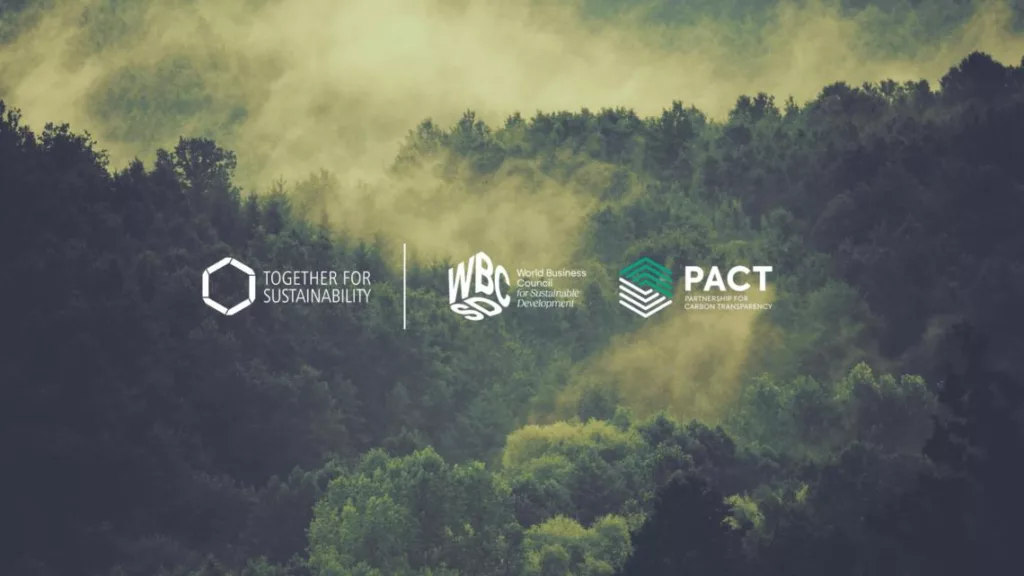
Boost for chemical sector decarbonization as industry initiative strengthens its collaboration with WBCSD’s Partnership for Carbon Transparency
19 September, 2023

U.S. Department of State’s Forest Investor Club Releases Inaugural Annual Report, Encouraging Billions in Nature-Based Investments
13 September, 2023

